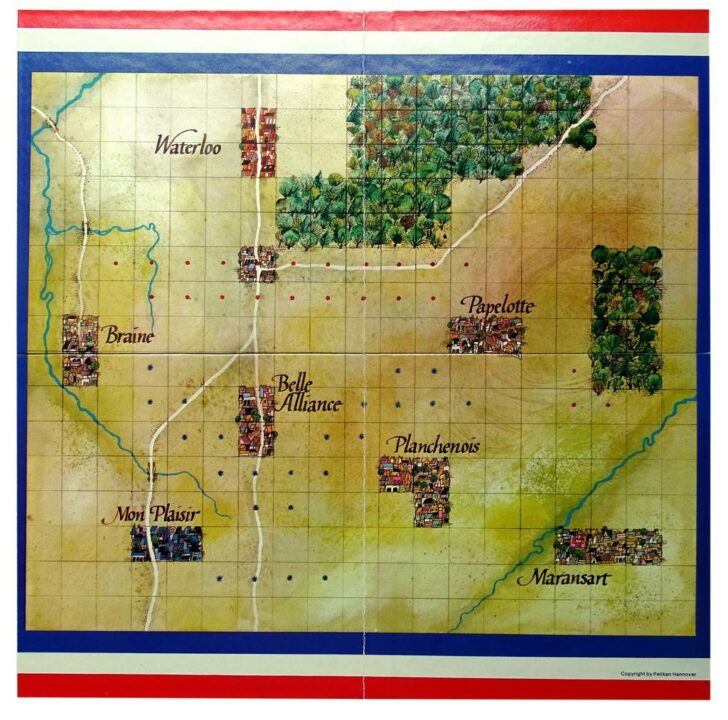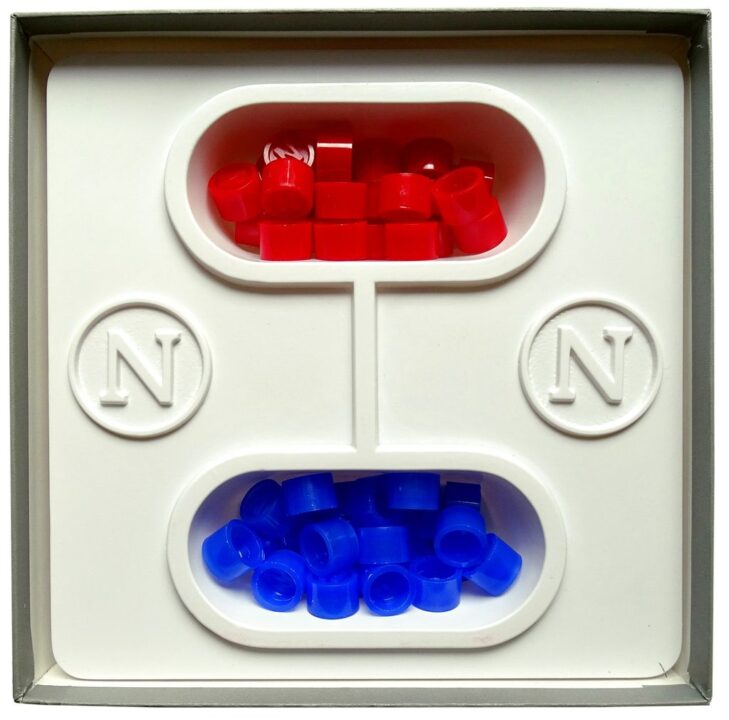Alright, gather round, fellow cardboard commanders! Today I’m reviewing Napoleon, the game that let me charge through Europe in my socks (because shoes are for losers, and I refuse to step on game boards with muddy boots). I played this with my regular band of misfits, and let me tell you, nobody left the table without an opinion – or without arguing about history. I’ll walk you through whether this game is just smoke and mirrors or if it’s worth the price of invading Russia in winter. Spoiler: there are dice, but my luck didn’t get exiled to Elba (this time).
How It Plays
Setting up
First, lay out the big map of Europe and place the British, Prussian, and French armies in their historical start spots. Don’t let me near the cardboard tokens or I’ll scatter them everywhere. Everyone grabs their side’s pieces, some dice, and a pile of tiny important-looking cards.
Gameplay
On your turn, move troops around, try to outsmart your friends, and roll dice in classic historical fashion. The French player usually tries to rush into Belgium faster than I can order a croissant, while the Allies scramble to block and trap. Reinforcements show up, battles break out, and sometimes wild luck sends Napoleon packing faster than you can say “Waterloo”. You’ll use cards for sneaky tricks and to pull off a surprise or two.
Winning the game
To win, the French must capture important cities before the Allied players can join forces and stop them. The Allies, meanwhile, win if they hold off the French long enough or KO Napoleon in a big battle. Let’s just say, my Napoleon hasn’t made it to Brussels in one piece yet.
Want to know more? Read our extensive strategy guide for Napoleon.
Does Napoleon Score a Win on Game Balance and Historical Accuracy?
If you love history like my friend Dave (who still writes letters with a quill pen), then Napoleon will catch your eye. The game’s box promises to bring the great battles of the Napoleonic era to your coffee table. But does it march to victory on balance and historical accuracy, or does it trip over its own epaulettes?
Let’s talk game balance first. When I played Napoleon, I noticed that neither side feels overpowered, at least not right out of the gate. Both the French and the Anglo-Allied armies have unique strengths. The French are bold and quick, and the Allies have strong positions and good reinforcements. But after three games, my group found that good old Napoleon himself (the character, not the short guy in my group who insisted on wearing a bicorne hat) often carries the French side pretty hard. If the French make a few smart moves early, the Allies can feel like they’re just hanging on for dear life. Balanced? Sort of. But keep your wits about you, or you’ll be Waterloo-ed before lunch.
Now, about historical accuracy. I’ll confess: I did not expect to learn this much. The map, unit design, and even the event cards try hard to mimic the real campaigns. You might even catch yourself spouting “Vive l’Empereur!” after a big win. Some details do get simplified (cavalry fans, prepare to grumble a bit), but overall, it’s one of the better attempts I’ve seen. Still, don’t expect a textbook—you’re here to play, not to pass a history exam.
Next up, I’ll talk about how Napoleon balances smart thinking with random dice luck – or if it leaves you crying into your baguette. Stay tuned!

Strategy Depth vs. Luck: Planning Your Waterloo Moment
Now, let’s talk about the real meat and potatoes in Napoleon: is this game a contest of wits or just luck of the dice? Trust me, after five games and a couple of heated debates with my friend Steve (he still claims he was “just testing my resolve”), I’ve seen both sides of the coin.
Napoleon sits in a neat spot between chess-like planning and nail-biting unpredictability. On one hand, you can spend ages plotting your troop movements, outmaneuvering your opponent, and building up for a grand attack. You get to think like a real general—staring at that map, twirling your invisible moustache, and feeling like you’re rewriting history itself. Strategy lovers will be happy: you can’t just stumble into victory without some clever thinking. Working out supply lines, timing reinforcements, and holding that one vital bridge—these things matter a ton.
But then, oh boy, the luck fairy sprinkles some chaos. Battles depend on dice rolls, so even the best-laid plans can go sideways faster than my diet at a pizza place. Sometimes you roll great and feel like a genius, other times your elite troops are wiped out by a single lucky regiment (cue Steve’s evil laugh). For me, this luck never felt unfair, but it did sting when a brilliant ambush fizzled because I rolled like a potato. If you want a pure brain-burner with zero randomness, this might not be your battlefield.
All in all, Napoleon rewards sharp minds but doesn’t completely ignore Mr. Chance. Next up? Let’s look at what your eyes and hands experience—the game’s component quality and board design. Get ready to judge with your fingers!

Napoleon Board Game: Component Quality and Board Design Review
Let’s get right to it: If you’re into games that look good on your table, Napoleon will probably not disappoint you. The board itself is chunky and hefty, like a baguette that could double as a weapon. It’s a map of Belgium, dotted with historic towns, winding roads, and forests that made me want to book an actual trip (but, you know, with fewer soldiers running around). Everything is clear and easy to read, even after my second cup of coffee.
The playing pieces have a classic charm. The wooden blocks—used to represent marching armies—feel satisfying in the hand. I admit, I spent a full minute just stacking them up before the game started, much to my friends’ annoyance. The stickers you need to apply yourself do require a little patience. I botched two, so now the Prussians look like they’re sneezing, but honestly, it gives them character. The cards are sturdy with a finish just grippy enough for shuffling but not so slick that you’ll fling them halfway across the battlefield (learned that lesson during my first play).
The rulebook deserves a quick shout-out for being both easy to follow and surprisingly short. Even my friend who usually zones out halfway through explanations managed to set up the whole board with only two mistakes. The whole package has that “old-school wargame” vibe, but doesn’t feel cheap or fragile. There’s a real sense that you own something special—just don’t eat chips over it, or you’ll regret it instantly.
Soon, I’ll tell you all about how Napoleon holds up with different numbers of players. Will it march to glory, or get bogged down in mud? Let’s find out together!

Napoleon: How Many Friends Should You Invite?
Let’s talk about the real question that plagues every board gamer: “Do I need to have a massive army of friends, or will my two buddies suffice?” Napoleon does not make this easy. My first game, we had three players—me, my overly competitive cousin Max, and Katie, the secret strategist. With three, Napoleon feels nicely tight. Everyone’s paranoid about flanks, alliances, and who’s hogging the snacks. The map gets crowded fast, and I’ll admit, it gets wild in a good way. Laughs, betrayals, and even a little historical reenacting—if you count Max doing a questionable French accent.
Once, we dragged in two more friends, making it five. It tilted the game big time. Turns stretched longer than Napoleon’s exile, and by hour three, the snacks ran out and so did my patience. Still, more backstabbing happened, and the diplomacy part really shined. If you like banter and don’t mind the game dragging a bit, five works… but wear comfy socks.
With just two players, Napoleon is still playable. But you miss the wild chaos of alliances, and it feels a bit more chess-like. Strategy is high, but the drama drops. Honestly, I loved it most with three or four. That’s the sweet spot—enough chaos to keep things interesting, not enough to make you regret inviting these people into your house.
If you want a game with strong replay value for your friend group, I recommend Napoleon. Just maybe don’t invite your entire battalion.
Conclusion
If you want a game that brings Waterloo to your kitchen table, Napoleon gives you a real clash of strategy and history. The board and pieces look sharp (unless you mess up the stickers like I did). It’s at its best with 3-4 players and the battles keep you thinking, even if the dice can sometimes throw your plans out the window. Replay value is solid, though long games with lots of players had my friends growing beards before we finished. Overall, I had a blast, but if you hate luck messing with your genius moves, you might want to look elsewhere. This wraps up my review—it’s been a wargaming ride!


